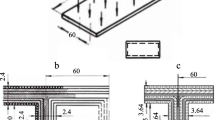Abstract
The in-plane compressive strength of a stiffened thin-skinned composite panel with a stress concentrator is examined. Two possible in-plane failure mechanisms are investigated. The first one is near-surface instability at the edge of the cutout, where high stress gradients are expected because of the stress concentration and the thickness heterogeneity of the laminated skin. Analytical 3D formulas allowing simple parametrical investigation of the phenomenon under consideration are derived. The second failure mechanism is fiber microbuckling in 0°-plies. An equivalent crack model is used to predict the compressive strength of a multidirectional composite laminate. How a stiffener affects the compressive strength of the thin-skinned panel with a hole is studied for both mechanisms. Experimental and predicted values of the critical load are in good agreement.
Similar content being viewed by others
REFERENCES
V. M. Bystrov, “Analysis of the decay of edge effects in laminated materials on the basis of a representative element,” Int. Appl. Mech., 36, No. 6, 826–834 (2000).
B. G. Falzon, D. Hitchings, K. A. Stevens, and G. A. O. Davies, Failure Prediction of Thick Structural Composites, Progress Report 3 (Ref. No. SMC/4/968), Imperial College of Science Technology and Medicine, Department of Aeronautics, London, UK.
E. Greenhalgh, S. Singh, D. Hughes, and D. Roberts, “Impact damage resistance tolerance of stringer stiffened composite structures,” Plast. Rub. Comp., 28, No. 5, 228–251 (1999).
A. N. Guz, Fundamentals of the Three-Dimensional Theory of Stability of Deformable Bodies, Springer-Verlag, Berlin-Heidelberg (1999).
A. N. Guz, “Description and study of some nonclassical problems of fracture mechanics and related mechanisms,” Int. Appl. Mech., 36, No. 12, 1537–1564 (2000).
A. N. Guz, “Constructing the three-dimensional theory of stability of deformable bodies,” Int. Appl. Mech., 37, No. 1, 1–37 (2001).
A. N. Guz and Yu. N. Lapusta, “Three-dimensional problems of the near-surface instability of fiber composites in compression (model of a piecewise-uniform medium),” Int. Appl. Mech., 35, No. 7, 641–670 (1999).
I. A. Guz and C. Soutis, “A 3D stability theory applied to layered rocks undergoing finite deformations in biaxial compression,” Eur. J. Mech., A/Solids, 20, No. 1, 139–153 (2001).
I. A. Guz and C. Soutis, “Compressive fracture of non-linear composites undergoing large deformations,” Int. J. Solids Struct., 38, No. 21, 3759–3770 (2001).
D. Hitchings, FE77 Users Manual, Imperial College, Aeronautics, London (1995).
D. C. Jegley, Effect of Low-Speed Impact Damage and Damage Location on Behavior of Composite Panels, NASA Technical Paper 3196 (1992).
A. W. Leissa, “An overview of composite plate buckling,” in: I. M. Marshall (ed.), Composite Structures, 4, Vol. I, Elsevier, London (1987), pp. 1.1–1.29.
M. P. Nemeth, Buckling and Post Buckling Behavior of Laminated Composite Plates with a Cut-out, NASA Technical Paper 3587 (1996).
J. C. Newman, “A nonlinear fracture mechanics approach to the growth of small cracks,” in: Proc. AGARD Conf. on Behavior of Short Cracks on Airframe Components, France (1982).
C. Soutis, “Damage tolerance of open-hole CFRP laminates loaded in compression,” Compos. Eng., 4, No. 3, 317–327 (1994).
C. Soutis and P. Curtis, “Prediction of the post-impact compressive strength of CFRP laminated composites,” Compos. Sci. Techn., 56, No. 6, 677–684 (1996).
C. Soutis and N. Fleck, “Static compression failure of carbon fiber T800/924C composite plate with a single hole,” J. Comp. Mat., 24, No. 5, 536–558 (1990).
C. Soutis and I. A. Guz, “On analytical approaches to fracture of composites caused by internal instability under finite deformations,” in: Proc. of EUROMECH Colloquium 400 on Impact and Damage Tolerance Modeling of Composite Materials and Structures (September 27-29), London (1999), pp. 51–58.
H. Tada, The Stress Analysis of Cracks. Handbook, Del Research Corporation, St. Louis Missouri (1974).
S. C. Tan, Stress Concentrations in Laminated Composites, Technomic Publ., Lancaster-Basel (1994).
S. P. Timoshenko and J. N. Goodier, Theory of Elasticity, McGraw-Hill, New York (1970).
V. A. Zarutskii, “Stability analysis of rectangular plates unidirectionally strengthened by ribs,” Int. Appl. Mech., 36, No. 4, 545–550 (2000).
V. A. Zarutskii, “The theory and methods of the stress-strain analysis of ribbed shells,” Int. Appl. Mech., 36, No. 10, 1259–1283 (2000).
Author information
Authors and Affiliations
Rights and permissions
About this article
Cite this article
Zhuk, Y.A., Soutis, C. & Guz, I.A. Stiffened Composite Panels with a Stress Concentrator Under in-Plane Compression. International Applied Mechanics 38, 240–252 (2002). https://doi.org/10.1023/A:1015729414684
Issue Date:
DOI: https://doi.org/10.1023/A:1015729414684




